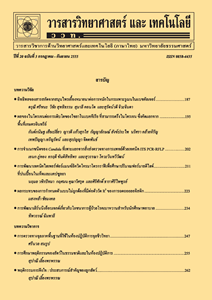Characteristics of Dried Bamboo Shoot Stick and Its Rehydration
Main Article Content
Abstract
The objectives of this research were to determine the uric acid content of steamed bamboo shoots compared to the fresh bamboo shoots, and to study the effect of drying conditions on the characteristics of dried bamboo shoots and their rehydration behavior. The drying conditions consisted of drying temperatures of 50, 60, and 70 ºC for 3 hrs. The results revealed that drying temperatures at both 60 and 70 ºC resulted in the dried bamboo shoot with a dramatic decrease in moisture content, high shrinkage, and low rehydration. Drying condition of 50 ºC for 120 min gave 5.68 % moisture content (wet basis) and 0.38 times of rehydration before steaming. Moreover, the rehydrated sample during boiling from 1 to 10 min was found that rehydration time did not affect lightness and a* of the rehydrated bamboo shoot. Rehydration times between 3 and 10 min resulted in the rehydrated bamboo shoot with a trend to increase rehydration ratio (p > 0.05). The firmness of bamboo shoots after drying at 7 and 8 min were 29.86 and 30.12 N, respectively.
Article Details
References
Bal, L.M., Kar, A., Satya, S. and Naik, S.N., 2010, Drying kinetics and effective moisture diffusivity of bamboo shoot slices undergoing microwave drying, Int. J. Food Sci. Technol. 45: 2321-2328.
Satya, S., Bal, L.M., Singhal, P. and Naik, S.N., 2010, Bamboo shoot processing: Food quality and safety aspect – A review, Trends Food Sci. Tech. 21: 181-189.
Ferreira, V.L.P., Yotsuyanagi, K. and Carvalho, C.R.L., 1995, Elimination of cyanogenic compounds from bamboo shoots Dendrocalamus giganteus Munro, Trop. Sci. 35: 342-346.
Tripathi, Y.C., 1998, Food and nutrition potential of bamboo, MFP News 8: 10-11.
Bhargava, A., Kumbhare, V., Srivastava, A. and Sahai, A., 1996, Bamboo parts and seeds for additional source of nutrition, J. Food Sci. Technol. 33: 146-146.
Teerapapthamkul, S., Tongpo, S., Jamsri, V., Promprasit, P., Unahalekhaka, J. and Chinwattanawong, P., 2019, Risk assessment of cyanide in bamboo shoots of Thai consumers, Dept. Sci. Serv. Minis. Sci. Tech. J. 53: 67-79. (In Thai).
Rawat, K., Nirmala, C. and Bisht, M.S., 2015, Processing techniques for reduction of cyanogenic glycosides from bamboo shoots, 10th World Bamboo Congress, Damyang.
Hafez, R.M., Abdel-Rahman, T.M. and Naguib, R.M., 2017, Uric acid in plants and microorganisms: Biological applications and genetics – A review, J. Adv. Res. 8: 475-486.
Halevi, S., Various Food Types and their Purine Content, Available Source: https://www.acumedico.com/purine, April 20, 2020.
Aichayawanich, S., Wongsa, J., Phungam ngoen, C. and Parametthanuwat, T., 2018, Degradation kinetics of cyanide and uric acid in bamboo shoot during boiling process, pp. 65-70, 8th International Conference on Bioscience, Biochemistry and Bioinformatics, Tokyo.
AOAC, 2000, Official Method of Analysis of AOAC International, Method 950.46, 17th Ed., The Association of Official Analytical Chemists, Maryland.
Kerdpiboon, S., Devahastin, S. and Kerr, W.L., 2007, Comparative fractal characteri zation of physical changes of different food products during drying, J. Food Eng. 83: 570-580.
Kirmaci, B. and Singh, R.K., 2018, Process severity affects texture and color of potato strips baked in pilot-scale infrared radiant wall oven, LWT Food Sci. Technol. 97: 261-268.
Silva, M.F., Menis-Henrique, M.E.C., Felisherto, M.H.F., Goldbeck, R. and Clerici, M.T.P.S., 2020, Bamboo as an eco-friendly material for food and biotechnology industries, Curr. Opin. Food Sci. 33: 124-130.
Kumar, P.S., Kanwat, M. and Choudhary, V.K., 2013, Mathematical modeling and thin-layer drying kinetics of bamboo slices on convective tray drying at varying temperatures, J. Food Process Preserv. 37: 914-923.
Rojas, M.L., Silveira, I. and Augusto, P.E.D., 2020, Ultrasound and ethanol pre-treatments to improve convective drying: drying, rehydration and carotenoid content of pumpkin, Food Bioprod. Process. 119: 20-30.
Devahastin, S., 2012, Drying of Foods and Biomaterials, Top Publishing, Bangkok, 344 p. (in Thai).
Curcio, S. and Aversa, M., 2014, Influence of shrinkage on convective drying of fresh vegetables: A theoretical model, J. Food Eng. 123: 36-49.
Silveira, I. and Augusto, P.E.D., 2020, Ultrasound and ethanol pre-treatments to improve convective drying: Drying, rehydration and carotenoid content of pumpkin, Food Bioprod. Process. 119: 20-30.
Devahastin, S. and Niamnuy, C., 2010, Modelling quality changes of fruits and vegetables during drying: A review, Int. J. Food Sci. Technol. 45: 1755-1767.
Nguyen, T.K., Mondor, M. and Ratti, C., 2018, Shrinkage of cellular food during air drying, J. Food Eng. 230:8-17.
Mayor, L. and Sereno, A.M., 2004, Modelling shrinkage during convective drying of food materials: A review, J. Food Eng. 61: 373-386.
McMinn, W.A.M. and Magee, T.R.A., 1997, Physical characteristics of dehydrated potatoes- Part II, J. Food Eng. 33: 49-95.
Avila, I.M.L.B., and Silva, C.L.M., 1999, Modelling kinetics of thermal degradation of colour of peach puree, J. Food Eng. 39: 161-166.
Bal, L.M., Kar, A., Satya, S. and Naik, S.N., 2011, Kinetics of colour change of bamboo shoot slices during microwave drying, Int. J. Food Sci. Technol. 46: 827-833.
Lee, H.S. and Coates, G.A., 1999, Thermal pasteurization effects on colour of red grapefruit juices, J. Food Sci. 64: 663-666.


